”It’s better to be chicken than stupid.”
That’s what my inner guru told me when I woke up at the Morar Hotel the morning of the start of The Great Outdoors Challenge, 2024
Morar is the toughest starting place on the west coast—steep, without trails or tracks for the first two days, with cliffs you’re tempted to get close to for ease of passage. I’d been encouraged to plan an alternative start in case I didn’t feel ready for it on starting day.
It was raining when I got up. I was hoping to meet some other Morar-starters in the hotel, get advice, and insinuate myself into their climb for the first two days, but there were none there.
Morar is reputed to have the most beautiful and isolated views on the west coast, but rain was predicted for at least a day so I wouldn’t be offered them. I’d purchased a find-my-crippled-body GPS beacon from REI (for $400) two days before I left Baltimore, but didn’t want to be so inhospitable as to use it.
Excuses? Of course.
I didn’t feel comfortable—I was too scared—to leave alone from Morar. So I took the train to Mallaig, seven minutes to the north.
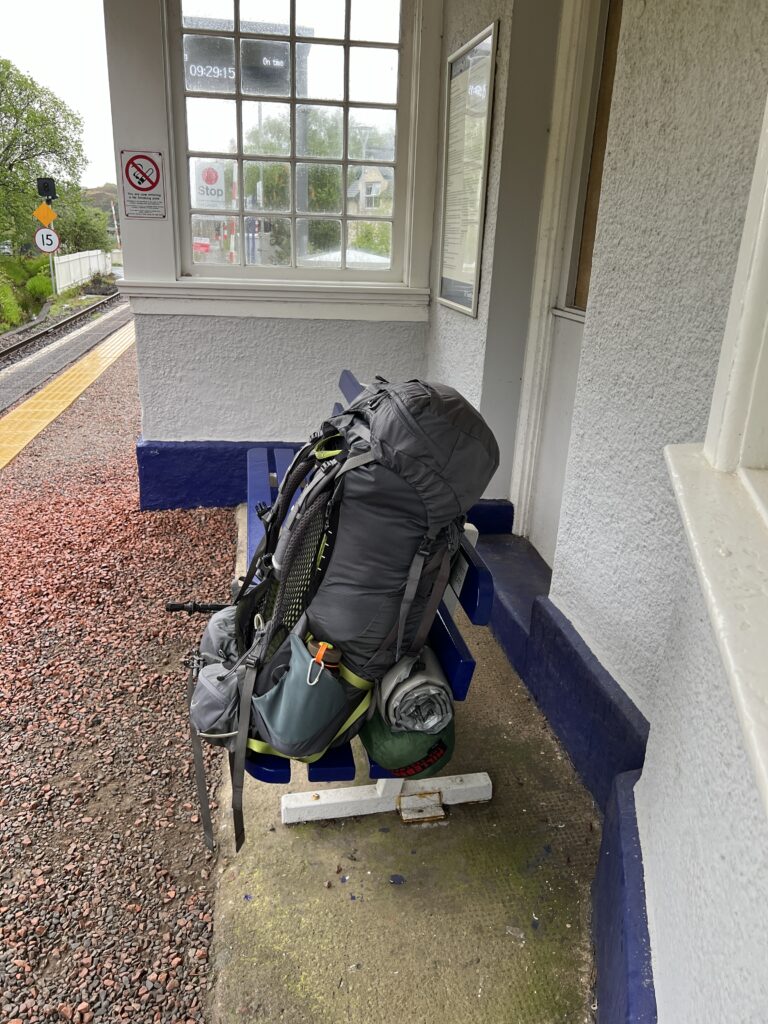
I started from Mallaig on my first Challenge, in 2014. It didn’t seem like old hat going back there.
Mallaig is a fishing village of about 850 people and about 50 active boats. Both numbers are greatly reduced from the old days. The herring—the main catch—are gone. Now the boats go after langoustines (large shrimp) and mackerel, among other species. About 3,500 farmed salmon are stunned, bled, and shipped out of Mallaig on trucks each day, too.

One of the deckhands was Alastair MacKellaig, 69. He made and sold ice for 40 years, retiring nine years ago and taking his current job. Mallaig isn’t what it used to be, he said.
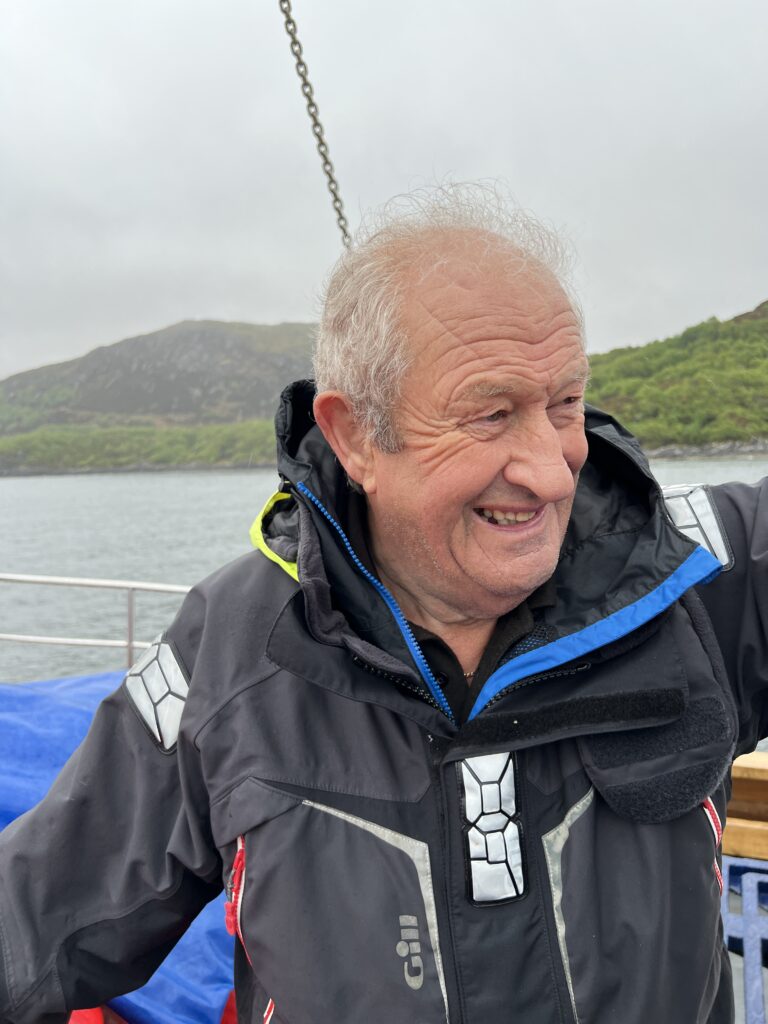
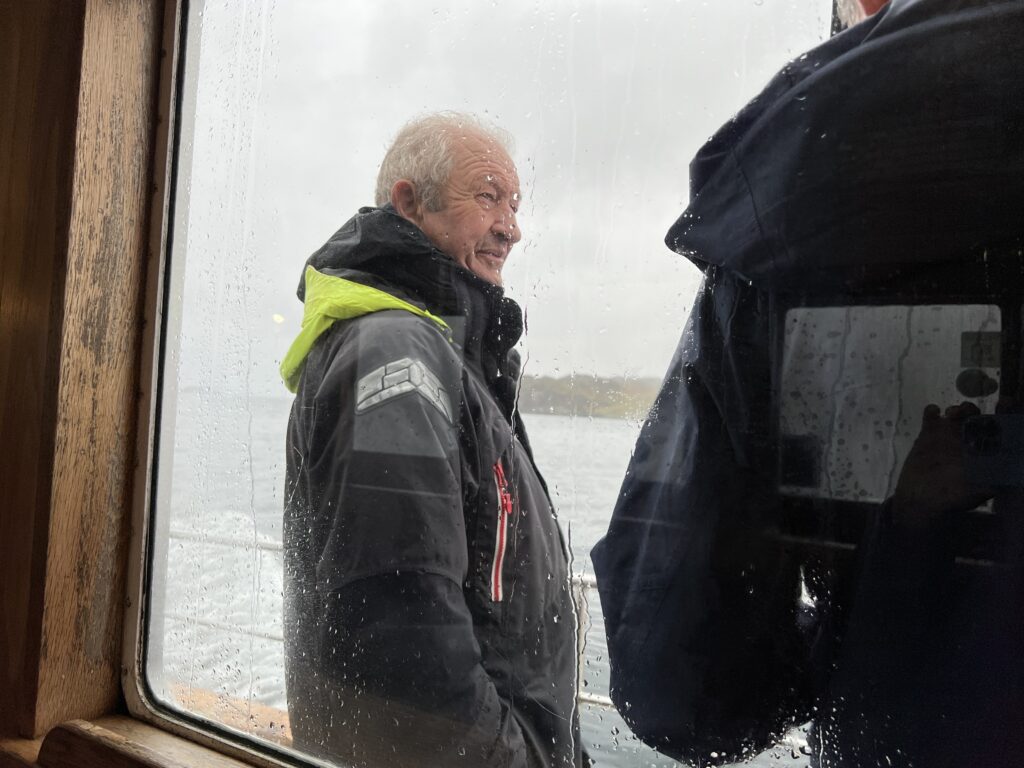
“Some of the boys would make 500 pounds a week when the herring was here. They bought a new car every year. The fishermen’s wives redecorated their houses twice a year.”
The ferry serves several villages on the jagged coastline, mostly carrying tourists. There were a half-dozen Challengers on the boat. They’re not hard to spot—white, gray-haired, and dressed in orange.

Our destination, 45 minutes away, was Inverie, at the edge of what was once a 17,000-acre estate.
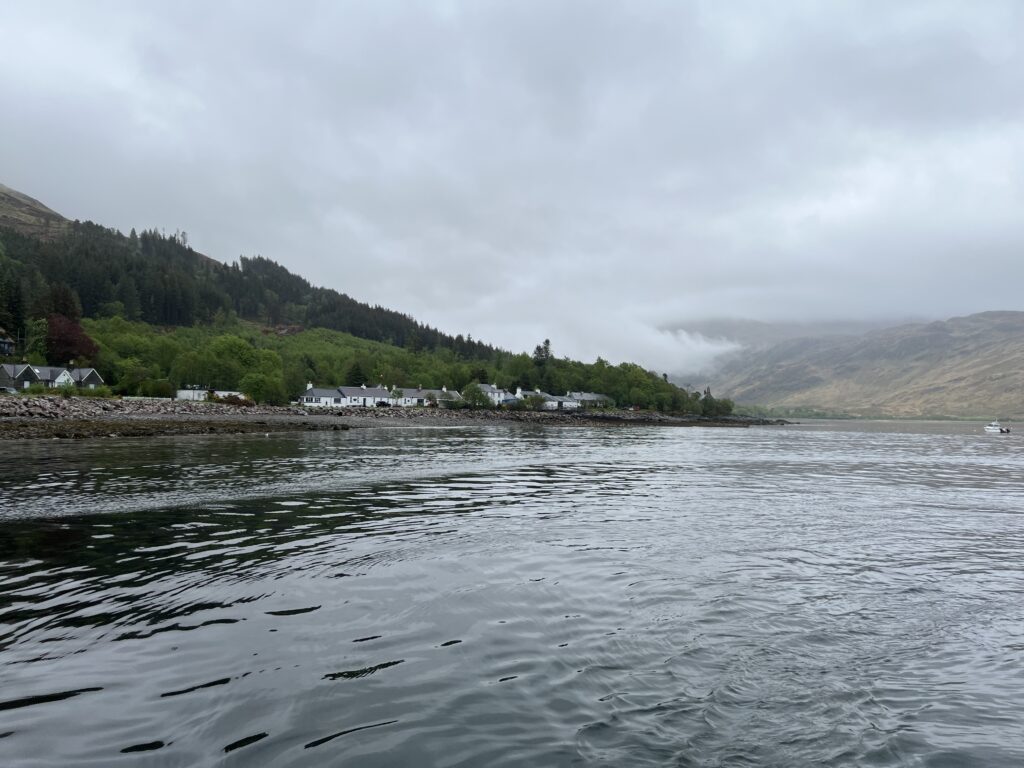
There’s a lot more tourist activity there now than 10 years ago. Before our packs were unloaded there was a bucket-brigade to take crates of vegetables, bags of potatoes, flats of berries, and boxes of pastries ashore.

The Old Forge, a watering hole where Challengers sometimes grab a last pint before heading off, wasn’t opened yet. There was a coffee shop doing brisk business. I stopped there for coffee and a scone. Another patron offered to take my picture as I maneuvered for a selfie.
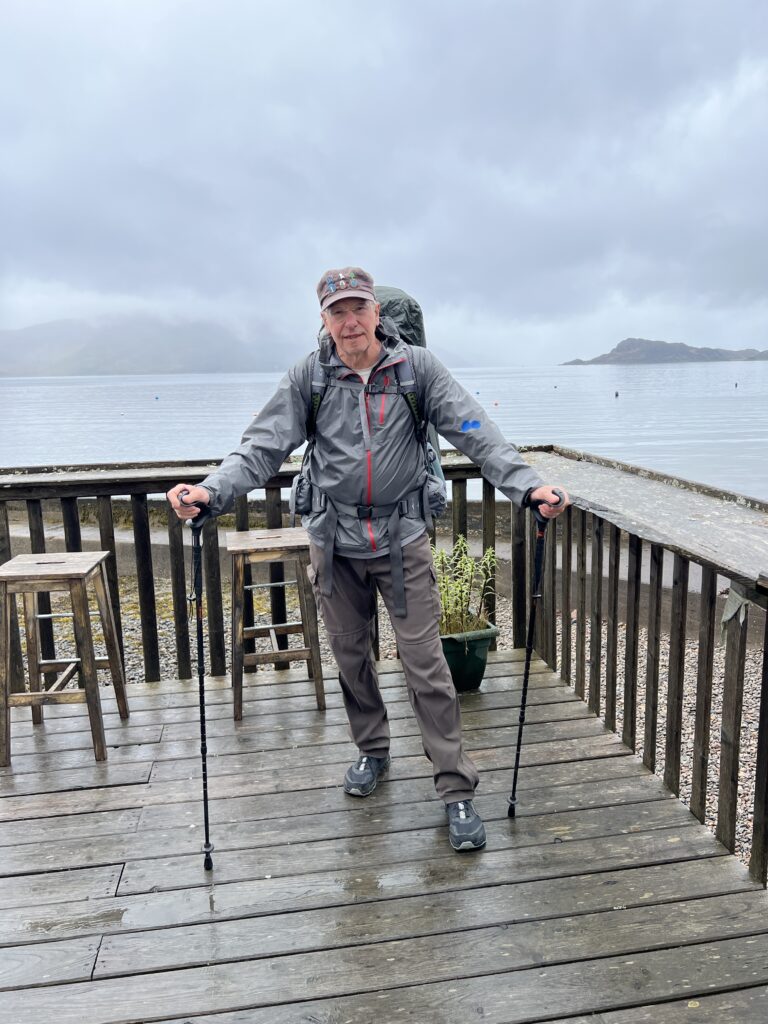
It was raining lightly. It was time to walk. I headed out of the village up a dirt road that, like so many, has a meticulously built stone wall along it. There aren’t many places in the world where moss grows this luxuriantly.

I was going up and over some hills, with my destination the end of a “sea loch,” a long fiord from the Atlantic Ocean. It would be about 2,400 feet up and 2,400 feet down, sea level to sea level.
Here are a few views looking back. In one are two ancient graveyards near an old house and some new ones.


Soon I came upon something I remembered from 10 years ago. I’ve seen a number of these in Scotland—monuments that aristocrats have built to themselves.
This is the Brocket Monument that was put up by Arthur Ronald Nall Nall-Cain, the 2nd Baron Brocket, in honor of his father. (My question: why not go for the hat trick and be Arthur Ronald Nall-Nall Nall-Cain?)

The second Baron Brocket was an unsavory figure. Here is Wikipedia on him:
Brocket became known in society as a Nazi sympathiser.[3] He became a committed member of the Anglo-German Fellowship, and his homes were used for entertaining supporters of Germany. Brocket, who considered Minister for Foreign Affairs Joachim von Ribbentrop a close personal friend, was so enamoured with Nazi Germany, he attended Hitler’s 50th birthday celebration in Berlin in 1939 . . .
At the outbreak of World War II in September 1939, Brocket continued to work for an understanding between Britain and Germany. He urged a negotiated peace settlement and tried to arrange talks with Hitler . . . However, Brocket was informed that the proposal to grant Germany control over Poland and Czechoslovakia was not acceptable to the British government.[5] Brocket was interned at the outbreak of war and his properties sequestrated by the War Office . . . The house and estate was taken over by the British Army when Brocket was interned; it was used to train commandos . . . After the war, the British government returned ownership of the estate to Brocket. He ordered that anything which might have been used or touched by [commandos] removed from Inverie House; all the cutlery, crockery and toilets were dumped in the sea at the mouth of Loch Nevis.
He was kind of an extreme version of Lord Darlington in Kazuo Ishiguro’s “The Remains of the Day.”
The rain came and went, never hard. Mist blew in and out, obscuring the tops of the hills and then revealing them. The path became a freshet of its own. It wasn’t full immersion until the end when I had to go through sphagnum bog, but my feet got wet pretty quickly. What did I expect? My boots were “waterproof”; it says so right on the inside next to the water stains!

I passed a ruin, but didn’t take time to explore it.

The deer can spot you from great distances. I guess that’s why they’re still around.

In the far right corner is the bog I had to walk across. And because the tide was in, I then had to go over the end of the land, not around it on the shore.

I finally got to Sourlies, the camping spot. There was a bothy, but it had three people in it, and in any case I preferred to sleep in a tent. I pitched mine next to a man named Hugh, who’d overtaken me late in the afternoon. (We’d chatted for a while.)
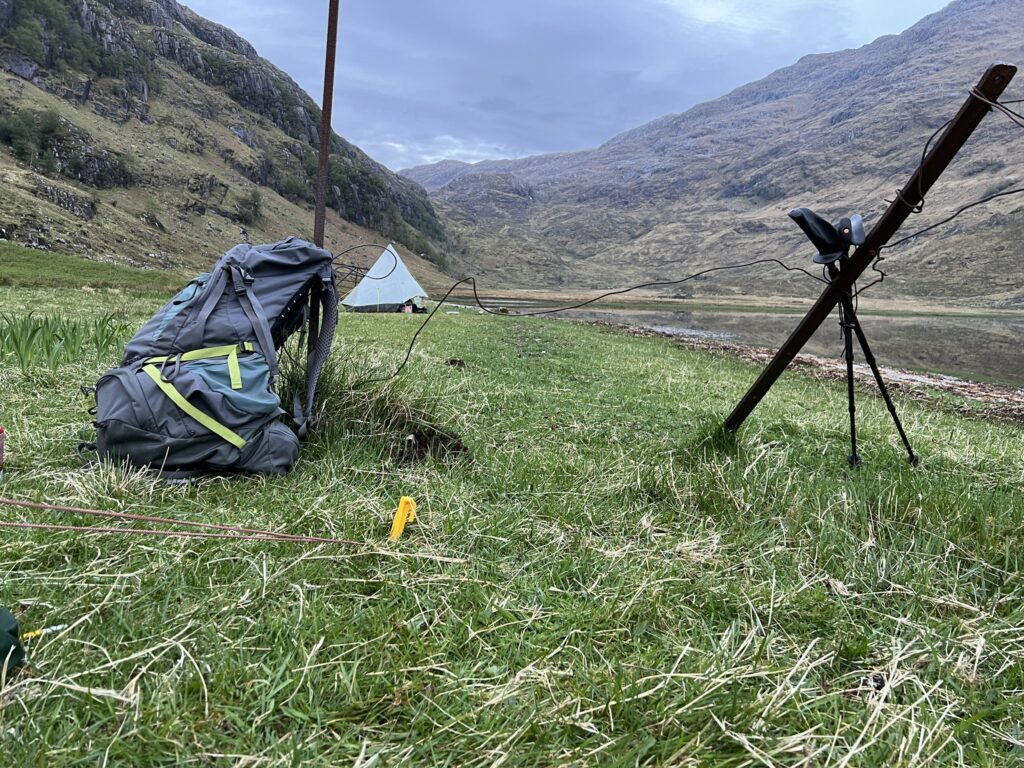
It had been a long hard day. (And, alas, one of the shorter ones!) I was in a beautiful place. This is a view out of the tent a little after 10 when I went to sleep.

Daunting-looking terrain. Your description of your fellow Challengers? (Orange highlights, partially waterproofed, white. tufts) Ducks!
Enough of Harrison Ford! You could be cover boy for AARP Magazine.